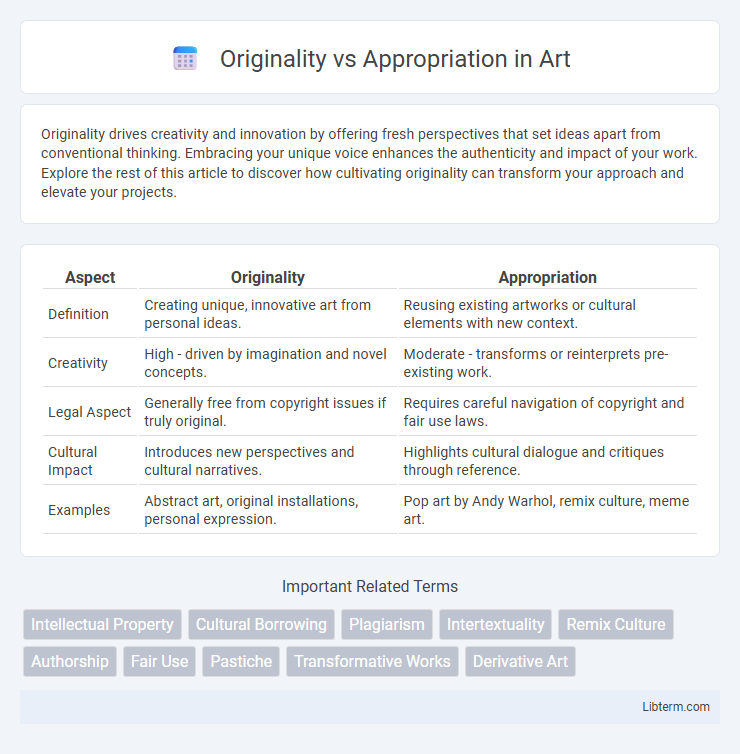Originality drives creativity and innovation by offering fresh perspectives that set ideas apart from conventional thinking. Embracing your unique voice enhances the authenticity and impact of your work. Explore the rest of this article to discover how cultivating originality can transform your approach and elevate your projects.
Table of Comparison
| Aspect | Originality | Appropriation |
|---|---|---|
| Definition | Creating unique, innovative art from personal ideas. | Reusing existing artworks or cultural elements with new context. |
| Creativity | High - driven by imagination and novel concepts. | Moderate - transforms or reinterprets pre-existing work. |
| Legal Aspect | Generally free from copyright issues if truly original. | Requires careful navigation of copyright and fair use laws. |
| Cultural Impact | Introduces new perspectives and cultural narratives. | Highlights cultural dialogue and critiques through reference. |
| Examples | Abstract art, original installations, personal expression. | Pop art by Andy Warhol, remix culture, meme art. |
Understanding Originality in Creative Works
Understanding originality in creative works involves recognizing the unique expression of ideas that reflect an artist's distinctive perspective and innovation. Originality is characterized by the combination of novel concepts, techniques, or themes that have not been directly copied or overly influenced by existing works. It emphasizes authenticity and the creation of something that contributes new value to cultural or artistic discourse, distinguishing genuine creativity from mere replication or appropriation.
Appropriation: Definition and Historical Context
Appropriation refers to the intentional borrowing or adoption of elements from one culture, artwork, or style by another, often raising debates about originality and authenticity. Historically, appropriation has been a common practice in art, evident from Renaissance painters drawing from classical motifs to modern artists incorporating pop culture imagery. This practice challenges conventional notions of creativity by blurring the lines between inspiration, homage, and cultural exploitation.
The Fine Line Between Inspiration and Imitation
The fine line between inspiration and imitation in originality versus appropriation hinges on the intent and transformation of existing ideas. Originality involves reinterpreting or innovating upon prior work, while appropriation often replicates without meaningful alteration or credit. Recognizing this distinction ensures creative integrity and respects intellectual property rights.
Artistic Innovation vs. Cultural Borrowing
Artistic innovation drives originality by introducing unique expressions and unprecedented creative techniques, fostering the evolution of art forms. Cultural borrowing, while enriching artistic practices through the integration of diverse traditions, risks diluting originality when it lacks contextual understanding or respect for source cultures. Balancing originality and appropriation requires mindful engagement that honors cultural origins while encouraging novel artistic contributions.
Ethical Questions Around Appropriation
Ethical questions around appropriation often center on the respect for cultural origins and the potential exploitation of marginalized communities without proper acknowledgment or compensation. Originality involves creating work that reflects an authentic voice or perspective, while appropriation risks misrepresenting or commodifying cultural elements for profit or aesthetic value. Navigating these issues requires a careful balance between inspiration and respect, emphasizing consent, context, and cultural sensitivity to avoid perpetuating harm.
Icons of Originality: Celebrated Examples Across Industries
Icons of originality, such as Steve Jobs in technology, Coco Chanel in fashion, and Banksy in street art, exemplify groundbreaking innovation that redefined their industries. These pioneers blend unique vision with cultural context, creating iconic works that resist mere appropriation by setting new creative standards. Their contributions highlight how original ideas drive progress, contrasting with appropriation's reuse of existing concepts without transformative insight.
Cases of Appropriation: Controversies and Debates
Cases of appropriation in art spark intense controversies surrounding cultural sensitivity, intellectual property, and artistic intent. Prominent examples include debates over the works of artists like Sherrie Levine and Jeff Koons, whose recontextualization of existing images questions the boundaries of originality. These controversies highlight complex discussions about the ethics of borrowing and the value of originality in contemporary creative expression.
Copyright Laws: Protecting Originality or Limiting Creativity?
Copyright laws aim to protect originality by granting creators exclusive rights to their works, preventing unauthorized use and ensuring recognition and financial reward. However, these laws can also limit creativity by restricting the appropriation and transformation of existing works, which often fuels innovation and cultural evolution. Balancing protection of original expression with allowances for fair use and derivative creativity remains a critical challenge in copyright legislation.
Cultural Sensitivity in Creative Expression
Originality in creative expression emphasizes unique cultural narratives, while appropriation risks misrepresenting or exploiting those traditions without proper context or respect. Cultural sensitivity requires artists to engage authentically with source cultures, ensuring representation honors the original meaning and significance. Recognizing power dynamics and seeking collaboration can prevent harmful stereotypes and foster genuine cross-cultural understanding.
Striking a Balance: Fostering Respect and Innovation
Striking a balance between originality and appropriation requires fostering respect for cultural and intellectual property while encouraging innovative reinterpretation. Emphasizing authentic engagement with diverse sources allows creators to transform inspiration into unique contributions without exploitation. Developing clear ethical guidelines and promoting cross-cultural dialogue enhances both creativity and mutual respect in artistic and academic fields.
Originality Infographic

 libterm.com
libterm.com